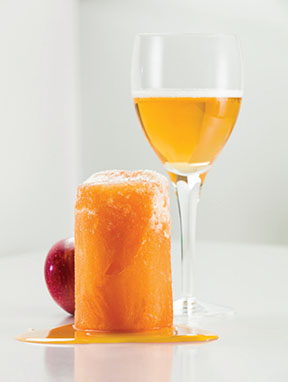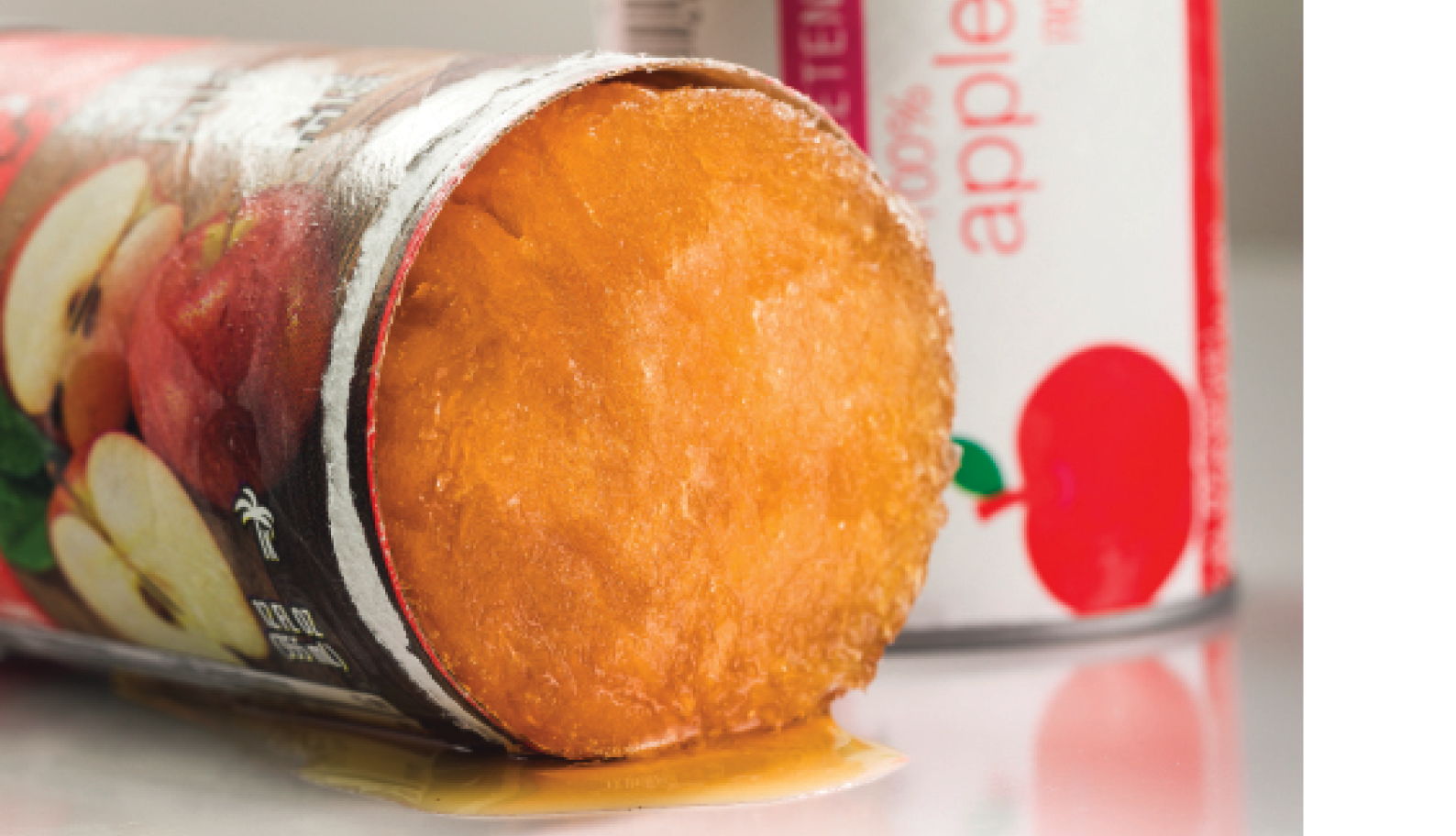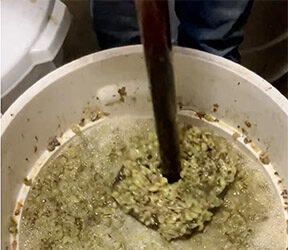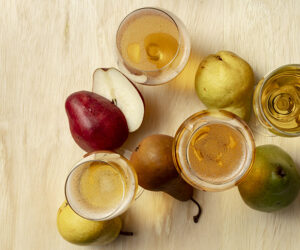 Over the past decade, cider has become the fastest growing category of alcoholic beverages worldwide, with close to a 15 percent annual growth rate in commercial sales in the United States and Canada and more than 70 cider festivals held annually between the two countries1. Worldwide, cider sales have grown by 350 percent over the same time2.
Over the past decade, cider has become the fastest growing category of alcoholic beverages worldwide, with close to a 15 percent annual growth rate in commercial sales in the United States and Canada and more than 70 cider festivals held annually between the two countries1. Worldwide, cider sales have grown by 350 percent over the same time2.
I caught the cidermaking bug myself in 2007, and now each fall I make cider from the Golden Delicious and Stayman Winesap apples in my backyard, along with an additional amount of apple juice from nearby orchards. This past fall, after processing and fermenting the juice from 600 pounds (272 kg) of apples, I left home on a three-week trip, but prior to departing, I stored 30 pounds/13.6 kg (about 3⁄4 of a bushel) of my remaining apples — which were destined for everyday eating — in my garage. Bad idea. What I didn’t figure on was that during my absence the temperature in the Milwaukee area would plummet to such a degree that the sequestered apples would simultaneously freeze and partially dry out in their now-icy habitat. Upon returning and discovering my slightly shriveled “applecicles” that no longer looked all that enticing as daily snacks, the following thought popped into my head: “Maybe it’s time to make ice cider!”
What is Ice Cider?
For those of you who know something about ice cider, you probably know why that question came to mind while I gazed at my shriveled and frozen fruit. For the rest of you, allow me to provide a little background information regarding this beverage. Traditional cider is a drink made by crushing and pressing apples and then fermenting the fresh-pressed apple juice, yielding an alcoholic drink of about 7% by volume. Ice cider, in contrast, involves the fermentation of concentrated apple juice that has had its sugar volume increased through the freezing and removal of a portion of the water in the juice, yielding a higher final level of alcohol following fermentation. The process not only concentrates the juice’s sugars, it also concentrates the juice’s apple flavor and malic acid, rendering an intensely flavored alcoholic cider that is typically consumed as a dessert drink.
The freezing process to partially remove water in the juice can occur through either cryoconcentration or cryoextraction, both of which operate on the principle that water freezes at a higher temperature than sugary juice. Most commercial ice ciders are made by cryoconcentration, which involves pressing the juice from apples and then partially freezing the juice to separate the high-sugar juice from the water prior to fermentation (see “Making Ice Cider” in the April-May 2011 issue of WineMaker for more on this method). A more natural method of achieving apple juice concentrate is the process of cryoextraction, which is also the traditional method used in making ice wine. In cryoextraction, orchard apples are allowed to remain on the trees well into the freezing depths of winter. Once harvested, this now-frozen and partly dried-out fruit is pressed to release its sugary concentrated juice, leaving water-based ice crystals behind. Many makers of ice cider believe that cryoextraction produces more fresh fruit flavors, increased acidity, and less oxidation than the cryoconcentration method.
How long has ice cider been made? Not centuries. If you ask citizens of Québec, they will proudly proclaim that one of their own created this delicious after-dinner drink in the small town of Dunham, and did so fairly recently, precisely in 1990. That year, winemaker Christian Barthomeuf developed a recipe and then worked with cidermaker François Pouliot to produce what would become known later as ice cider. Today, ice cider is widely distributed by Québec’s government-run liquor stores and is protected by law with a reserved appellation. Québec Ice Cider, or Cidre de glace, is produced by the fermentation of this concentrated sugary apple juice, which must have a pre-fermentation sugar concentration of at least 30 °Brix sugar derived solely by the natural cold and have a residual sugar content after fermentation of at least 130 grams per liter. Further, the final alcohol content must be over 7% and less than 13% by volume. During the cidermaking process, no additional sugar (chaptalization), alcohol, artificial flavoring, or coloring can be used. Also, no commercial concentrated apple juice can be added, and all apples must be cultivated, pressed, prepared, and bottled on site by the producer.
a “Relative” of Apple Jack
If we define ice cider by the strict rules outlined in Québec law then it is clearly the case that this drink is only 27 years old, which makes it a baby in the world of alcoholic beverages. Yet it is also the case that this beverage has a very close but much stronger spirited “relative” dating back to North America’s colonial days that went by the colorful name of apple jack. This special cider was so named because (1) apples were used to make it and (2) the process by which it was produced is known as fractional freezing, which was referred to as “jacking” back then. Apple jack is a strong alcoholic beverage made by concentrating already-fermented cider using the freeze method of distillation (based on the fact that alcohol freezes at a lower temperature than water).
In the 1700s, farmers would first crush, press, and ferment their apples in the traditional manner to make cider and then, during the cold days and nights of winter, they’d set some barrels of already-fermented cider outdoors to partially freeze so that the water portion of the fermented cider could be removed as ice, leaving behind a more concentrated slushy alcoholic liquid. By repeating this process at increasingly lower temperatures, the farmers eventually raised the alcohol level of this greatly concentrated hard cider up to 25–40% by volume, which is considerably higher than the alcohol levels found in today’s ice cider. George Washington made apple jack at his Mount Vernon, Virginia residence along with his regular cider, whiskey, and beer. During America’s colonial period, apple jack was so valued that it was often used as currency to pay workers for their services.
One of the primary differences between ice cider and apple jack — besides how concentration is achieved and their different levels of alcohol — is that, with ice cider you will most likely have a final product with a pleasant amount of residual sweetness, because you start fermentation with enough sugar to go above the alcohol tolerance of most yeasts, whereas with apple jack there is typically very little residual sugar in the fermented cider prior to it being frozen, therefore your final product will be very dry.
Making a Quick Version of Ice Cider
So, let’s return to my situation where I had partially dehydrated and frozen apples in my sub-freezing garage. Normally, 30 pounds (13.6 kg) of freshly picked apples yields about 1 gallon (4 L) of juice after crushing and pressing. I quickly realized that my small supply of frozen apples would not provide nearly enough concentrated juice for ice cider, so I needed to think “outside the box” in deciding how to proceed. After mulling over this situation for a few minutes I concluded it was time to improvise. Perhaps I could use my paltry cache of frozen apples as a “tip of the hat” towards traditional ice cider while pursuing a variation of this drink. However, in doing so, I realized that I would be breaking at least one cardinal Québec rule, because I would need to use commercial apple juice concentrate in making this ice cider variation. In planning my next steps, I thought back to how I would sometimes supplement the juice obtained from my backyard apples and local apple orchards with a small amount of grocery store frozen apple juice concentrate to increase my final yield of regular cider. The concentrate that I used comes in 12-ounce (340-g) plastic containers from my neighborhood grocery store, with no additional sugar added and no sulfites to hinder fermentation.
The recipe at the end of this article yielded 3 gallons (11.3 L) of this ice cider variation. As is described in the making of traditional ice cider in the story referenced earlier, if you start with 5 gallons (19 L) of freshly pressed apple juice, after freezing and then slowly thawing it out to draw off the apple juice concentrate, you will end up with 11⁄2 gallons (6 L) of cider concentrate, or 30 percent of the original volume, which is then fermented to make ice cider. Yet by starting with the store-bought frozen apple juice concentrate, I realized that I could essentially skip the crushing and pressing of the apples, the freezing of the apple juice, and the slow thawing out and drawing off of the apple juice concentrate. My technique would both greatly reduce labor time, as well as reduce the waiting time to enjoy the finished product. Indeed, from the onset of fermentation to bottling, a mere six weeks passed. Normally, I avoid cutting corners in my cidermaking, but I kept reminding myself that this was an experiment to determine whether a good-tasting facsimile of ice cider could be made quickly using store-bought juice concentrate.
After two days of fermenting at room temperature the specific gravity measured 1.050 and fermentation was so vigorous that I placed the carboy into a cool-water bath in my sink to slow it down a bit and maintain a temperature of 55 °F (13 °C). Ten days later, the fermenting juice had reached a gravity of 1.000, at which point I halted fermentation with sulfite and potassium sorbate. After bulk aging for four weeks my pH level was at 3.13 and my titratable acidity (TA) was at a whopping 1.0%, which isn’t all that surprising because I’m sure all that concentrated apple juice contained a hefty portion of malic acid. I then calculated the alcohol content of this finished cider by subtracting the last specific gravity reading from the starting gravity and dividing the result by 0.0074, which gave me the approximate alcohol content of 12.4% by volume.
Because I desired a sweeter dessert drink than I’d have with a SG of 1.000 I back-sweetened the cider with three additional 12 fl. oz. (0.35 L) containers of apple juice concentrate. Adding in that extra 36 oz. (1 kg) of alcohol-absent concentrate increased my total volume to 3 gallons (11.3 L) and reduced my final alcohol level to 11.3%, which is towards the upper end of the “greater than 7%” and “lower than 13%” range of true ice cider. The residual sugar level measured 15%.
Because of the high alcohol content, I decided to use 7 fl. oz. (0.21 L) capped cider bottles for this dessert drink, an amount that will fill two small after-dinner glasses. After bottling I decided to play it safe, so I temporarily placed this ice cider variation into my garage refrigerator to guard against further fermentation occurring in these small bottles loaded with residual sugar. Because I had already added sulfite and sorbate I realized that I was being extra cautious, but better safe than sorry. I then placed six of the bottles inside my warm, cozy office area and waited to see if they began exploding. Each week over the next six weeks I opened up one of these bottles for a taste, and each week there was never a hint of CO2 fizz. After drinking the sixth and final bottle, any concerns I had about bottle fermentation were dispelled and I moved all the remaining cider into my cellar for aging (and drinking).
Three months after bottling I brought samples of this ice cider variation to the monthly meeting of the Wisconsin Vintners Association and asked members to provide feedback. Everyone was impressed with the appearance, aroma, and taste of this cider, as well as its acid/sweetness balance. Honey-colored in appearance, it has a nice, clean nose and a tart and crisp, yet intensely sweet, green-apple taste. Despite the high alcohol and acid content, there is no alcohol burn or acid bite in the taste. Instead, there is a complexity to the flavor that lingers on the palate long after the sweetness has dissipated. I believe that this variation of ice cider can be aged for about five years or so, but may be at its best in the first two to three years.
Because I have disquieting visions of the Canadian Mounties pounding on my door and dragging me off to ice cider prison for tinkering with Québec law, I will refrain from declaring this recipe yields a dessert drink that rivals those made using the labor-intensive methods specified by the province’s reserved appellation rules, but I am declaring that this ice cider variation is one flavorful drink!
Resources:
1 https://ciderguide.com/cider-festivals/
2 https://www.statista.com/statistics/300874/global-dollar-sales-of-cider/

Quick Ice Cider (3 gal./11.3 L)
Ingredients
3⁄4 bushel frozen apples
17 containers of apple juice concentrate
21 cups of water
5 grams of Côtes des Blancs yeast
Yeast nutrient
1⁄4 teaspoon (1.1 g) of FT Rouge Tannin
1⁄2 teaspoon ICV Noblesse nutrient
Sulfite
Potassium sorbate
Step by step
You can add two additional containers of frozen juice concentrate instead of the small addition of juice from frozen apples if you wish. However, if you do add them just as I did, press the frozen apples and mix the juice with 14 containers of concentrate and water into a 3-gallon (11.3-L) carboy. This should result in a starting Brix of 22 (SG = 1.092). Add the yeast, 5 grams of yeast nutrient, FT Rouge Tannin, and ICV Noblesse nutrient. Fermentation should be visible within 24 hours. Two days after the onset of fermentation, lower fermentation temperature to around 55 °F (13 °C) and add another 1⁄2 teaspoon (2.2 g) of yeast nutrient to maintain a healthy fermentation. When the juice reaches a gravity of 1.000 (about 10 days), add sulfite and potassium sorbate to the cider to prevent further fermentation. Allow the cider to bulk age for four weeks. Rack cider into a bottling bucket and back-sweeten with three additional containers of apple juice concentrate (or at a rate based on your preferred sweetness). Bottle as usual.






